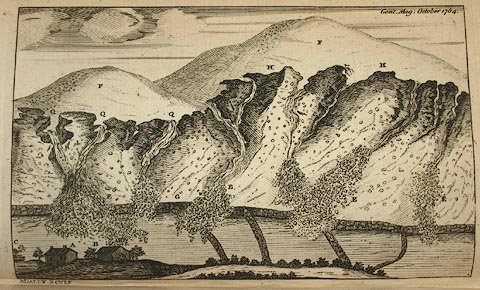

Armitt Library : Gents Mag 1754.1
image:-
© see bottom of page

click to enlarge
Tipped in opposite p.465 in the Gentleman's Magazine vol.24, 1754.
There is accompanying text pp.464-465:-
'THERE happened about four years ago a most dreadful storm of thunder and ligtening (sic), in these parts, which bursting over the mountains, was attended with such a torrent of rain, as considerably changed the face of the country, and did incredible damage, in the vale below'
'The vale is called St John's Vale, and as I lately passed through it, I took a draught of the mountains, as they now appear, which I send you, with a more particular account of the storm, than has been yet published.'
'The precipices on the left of this vale, as you pass along the road D from Keswic to Ambleside, very much resemble volcano's, and look as if they were half burnt. The ascent is for several miles covered with rude fragments of different sizes and figure, which storms and torrents have torn from the native rock, and is ploughed into many hollows, down which the cataracts have poured, when a water cloud has been broken at the top, which very frequently happens, and produces such rain, as the inhabitants of level countries have never seen.'
'Above these precipices other mountains, still higher, terminate the view, and the vale below is a narrow, but fertile spot, the inhabitants of which, have, from time to time, removed the loose stones, which were driven down upon them, and formed them, by degrees, into a fence, against the fury of other inundations.'
'The hollows, or channels which wind down the declivity, and when I saw them were dry, become gradually wider, and more shallow, as they descend to that part of the mountain which is less steep; the waters in proportion as they spread, lose their force, cover a larger tract, and fall with less rapidity.'
'In the afternoon, which preceded the storm, it was perceived to thunder and lighten incessantly beyond Skiddow, (see v.18 p.291.) is one of our highest mountains, the cloud from which the tempest proceeded, came at length, up to the mountain, but not being high enough to pass over it, divided, one half of it went away north east, and meeting with no opposition, it discharged a great quantity of water, on the plains of Wigton, and Carlisle, over which, it hovered till about nine o'clock at night, and then moved farther in the same direction, but so slowly that its explosions were not out of hearing till two in the morning.'
'The other half went through a vale called Threlcot, and over the rocks on one side of Keswic, called Lady Rocks, meeting no opposition till it came to the mountains which bound St John's vale, and by these it was stopped. It became every moment more dense, by the accession of vapours, which being still in motion, pressed upon it, and soon after it poured down a torrent of rain, which lasted eight hours. The thunder still continued, and the darkness which might almost be felt, became more dreadful by the flashes which broke it at short intervals with a sulphureous light; to the noise of the thunder, was added that of the cataracts, and of the fragments of the rock, which they drove before them; the fences were overturned in a moment, the fields covered with the ruins of the mountains, under which, the cottages were first crushed, and then swept away by the torrent. The inhabitants, who were scarce less astonished and terrified, than they would have been at the sound of the last trumpet, and the dissolution of nature, ran together from under the roofs that sheltered them, less they should be beaten in upon their heads, and finding the waters rush down all round them in an impetuous deluge, which had already covered the ground, such of them as were able, climbed the neighbouring trees, and others got on the tops of hay stacks, where they sat exposed, at once, to the lightening and the rain, discovering by the light of every flash, some new ruin, and every moment expecting that the trees to which they had fled for safety, should be torn up by the roots, and the hay overturned by the innundation.'
'It is perhaps impossible, for the strongest imagination to accumulate circumstances of greater horror, and these were produced by a concurrence of various causes, which perhaps may happen no more. I have therefore been particular in my account, in hopes that you will preserve it to posterity, and the rather as I find in the memorials of your royal society, and of the academies abroad, that such events are never thought below their notice.'
Cockermouth, Cumberland, October 3, 1754. Yours &c. G.S.
'Description of the PLATE.'
'A, a farm house that was abandoned that night.'
'B, a mill that was demolished.'
'C, stacks and trees where a farmer saved himself and his family.'
'D, the high road from Keswic to Ambleside.'
'E cataracts of stone and water over-turning the wall G in many places.'
'F, high mountains about a mile in acclivity beyond the rugged hill H H, which furnished water to fill the channels and which stopped the tempestuous cloud.'
'Q Q Q channels formed by the descending conflux of waters from the mountains F F.'
The view looks towards the East; the two background hills are Clough Head and Great Dodd.
Gent : Mag : October 1754.
M DARLY SCULP

 Gents Mag
Gents Mag